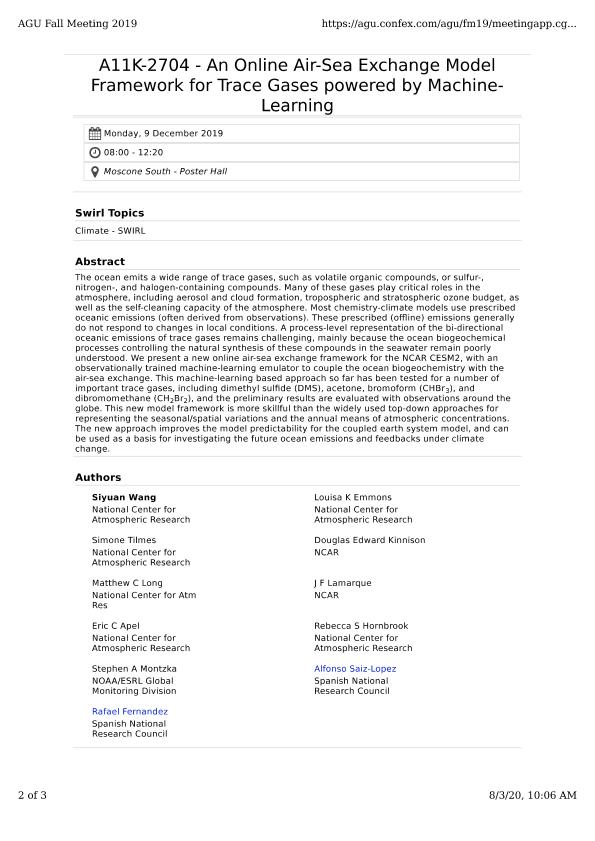Evento
An online air-sea exchange model framework for trace gases powered by machine- learning
Wang, Siyuan; Emmons, Louisa K.; Tilmes, Simone; Kinnison, Douglas E.; Long, Mateo C.; Lamarque, Jean Francoise; Apel, Eric C.; Hornbrook, Rebecca S.; Montzka, Stephen; Saiz López, Alfonso; Fernandez, Rafael Pedro

Tipo del evento:
Reunión
Nombre del evento:
American Geophysical Union Fall Meeting
Fecha del evento:
09/12/2019
Institución Organizadora:
American Geophysical Union;
Título del Libro:
Abstracts of the American Geophysical Union Fall Meeting
Editorial:
American Geophysical Union
Idioma:
Inglés
Clasificación temática:
Resumen
The ocean emits a wide range of trace gases, such as volatile organic compounds, or sulfur-,nitrogen-, and halogen-containing compounds. Many of these gases play critical roles in the atmosphere, including aerosol and cloud formation, tropospheric and stratospheric ozone budget, as well as the self-cleaning capacity of the atmosphere. Most chemistry-climate models use prescribed oceanic emissions (often derived from observations). These prescribed (offline) emissions generally do not respond to changes in local conditions. A process-level representation of the bi-directional oceanic emissions of trace gases remains challenging, mainly because the ocean biogeochemical<br />processes controlling the natural synthesis of these compounds in the seawater remain poorly understood. We present a new online air-sea exchange framework for the NCAR CESM2, with an observationally trained machine-learning emulator to couple the ocean biogeochemistry with the air-sea exchange. This machine-learning based approach so far has been tested for a number of important trace gases, including dimethyl sulfide (DMS), acetone, bromoform (CHBr 3 ), and dibromomethane (CH 2 Br 2 ), and the preliminary results are evaluated with observations around the globe. This new model framework is more skillful than the widely used top-down approaches for representing the seasonal/spatial variations and the annual means of atmospheric concentrations. The new approach improves the model predictability for the coupled earth system model, and can be used as a basis for investigating the future ocean emissions and feedbacks under climate change.
Palabras clave:
SEA-AIR EXCHANGE
,
VSL HALOGENS
,
CAM-CHEM
,
MACHINE LEARNING
Archivos asociados
Licencia
Identificadores
Colecciones
Eventos(CCT - MENDOZA)
Eventos de CTRO.CIENTIFICO TECNOL.CONICET - MENDOZA
Eventos de CTRO.CIENTIFICO TECNOL.CONICET - MENDOZA
Eventos(ICB)
Eventos de INSTITUTO INTERDISCIPLINARIO DE CIENCIAS BASICAS
Eventos de INSTITUTO INTERDISCIPLINARIO DE CIENCIAS BASICAS
Citación
An online air-sea exchange model framework for trace gases powered by machine- learning; American Geophysical Union Fall Meeting; San Francisco; Estados Unidos; 2019; 1-1
Compartir



